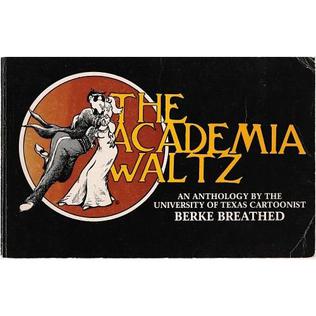 W
WThe Academia Waltz was Berkeley Breathed's first comic strip, published daily from 1978 to 1979 in The Daily Texan at The University of Texas at Austin, where he was a student. The strip focused primarily on college life, although it sometimes made references to big news stories of the time.
 W
WAlec the Great was a syndicated newspaper gag panel created by Edwina Dumm and featuring a dog character. It ran from 1931 to 1969.
 W
WThe Angriest Dog in the World is a comic strip created by film director David Lynch.
 W
WAsk Shagg was a syndicated daily comic strip drawn by cartoonist Peter Guren from 1980 to 2020. It was distributed by Creators Syndicate; it had been distributed by United Feature Syndicate from 1980 until 1995. The strip has run in dozens of newspapers including The Boston Globe, The Columbus Dispatch, and the Seattle Post-Intelligencer. In each strip Guren, through his Shagg E. Dawg character, answered questions from readers about the animal kingdom. The strip retired on the 5th of January, 2020.
 W
WBeasts of Burden is a comic book series created by writer Evan Dorkin and artist Jill Thompson, and published by American company Dark Horse Comics. The title centers on an eponymous team of intelligent animals that investigate different paranormal events that occur in their small neighborhood of Burden Hill. The initial group consists of five dogs and a cat. They are often seen consulting with "Wise Dogs," local shamanic elders of their community.
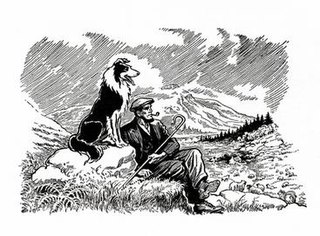 W
WBlack Bob was the name of a fictional Border Collie from Selkirk in the Scottish Borders; his 'owner' was Andrew Glenn, a bearded shepherd. Black Bob originally appeared as a text story in The Dandy in issue 280, dated 25 November 1944; in that story, Black Bob follows his owner's nephew who is playing truant and tries to bring him back to school.
 W
WBoes is a Dutch newspaper gag-a-day comic strip created by Wil Raymakers and Thijs Wilms. It was created in 1980 and spawned a popular anime television series between 1988 and 1991 called Ox Tales in the English-speaking world. The comic managed to outlive the animated adaptation and still continues to appear as a column strip in several Dutch daily and weekly newspapers.
 W
WBonzo the Dog is a fictional cartoon character first created in 1922 by British comic strip artist George Studdy. The pup quickly rose to popularity in the 1920s. He starred in one of the world’s first cartoons, became an inspiration for mass-marketed merchandise, and became a favourite among children and adults.
 W
WBoule et Bill is a popular comic, created in 1959 by Belgian writer-artist Jean Roba in collaboration with Maurice Rosy. In 2003, the artistic responsibility of the series was passed on to Roba's former assistant Laurent Verron. The stories center on a typical family: a man and his wife, their young son Boule and Bill the cocker spaniel.
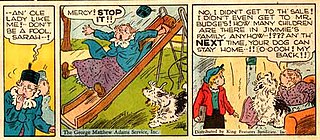 W
WCap Stubbs and Tippie is a syndicated newspaper comic strip created by the cartoonist Edwina Dumm that ran for 48 years, from August 21, 1918 to September 3, 1966. At times the title changed to Tippie & Cap Stubbs or Tippie.
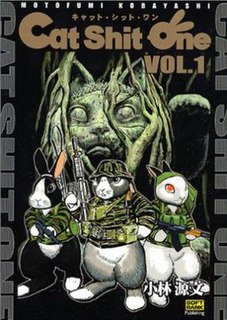 W
WCat Shit One is a three volume manga series written and illustrated by Motofumi Kobayashi. It was published in North America and the United Kingdom in 2004 by ADV Manga. It was also released in Poland in 2006, also under the title Cat Shit One. It has been released in France, Belgium and Spain, as Cat Shit One, by Glénat in 2006.
 W
WCathy is an American gag-a-day comic strip, drawn by Cathy Guisewite from 1976 until 2010. The comic is about a woman, Cathy, who struggles through the "four basic guilt groups" of life—food, love, family, and work. The strip gently pokes fun at the lives and foibles of modern women. The strip debuted on November 22, 1976, and appeared in over 1,400 newspapers at its peak. The strips have been compiled into more than 20 books. Three television specials were also created. Guisewite received the National Cartoonists Society Reuben Award in 1992 for the strip.
 W
WCubitus is a Franco-Belgian comics series, and the basis for the Wowser cartoon series appearing in the United States. Cubitus was created by the Belgian cartoonist Dupa, and features Cubitus, a large anthropomorphic dog, who lives with his owner Semaphore. Cubitus is known as Dommel in Flanders and the Netherlands, Muppelo or Pom Pom in Finland, Teodoro in Italy and Доммель in Russia. His name derives from the old anatomical name of the ulna bone, supposedly derived from the Greek kybiton (elbow).
Deflocked is a comic strip written and illustrated by Jeff Corriveau, which follows the adventures of four major characters, described as "deliriously funny yet seriously dysfunctional." The strip, which Corriveau originally based loosely on Hippocrates' Four Humours attempts to detail relationships similar to Norman Lear’s All in the Family through the exploits of Mamet, a wayward sheep, the dog siblings Cobb and Rupert, and Tucker, an 8-year-old boy raised by the dogs. The strip was syndicated in May 2008.
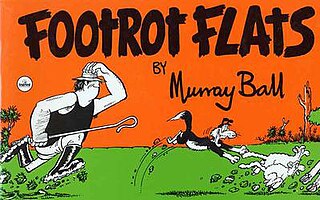 W
WFootrot Flats is a comic strip by New Zealand cartoonist Murray Ball. It ran from 1976 to 1994 in newspapers, though unpublished strips continued to appear in book form until 2000. Altogether there are 27 numbered books, a further 8 books collecting the Sunday newspaper strips, and 5 smaller 'pocket' books of original material, plus various related publications. There was also a stage musical, an animated feature film called Footrot Flats: the Dog's Tail Tale, and even a theme park in Auckland, New Zealand. The strip reached its peak of popularity in the mid-1980s, with the books selling millions of copies in Australasia.
 W
WGai-Luron is a French comics series about a melancholic basset hound, Gai-Luron, created on July 12, 1964 by Gotlib. Originally published in the Franco-Belgian comics magazines Vaillant and Pif Gadget, the character joined Nanar, Jujube et Piette, which Gotlib had drawn since 1962, but eventually headlined a hit series of its own. The album collection series started in 1975, and the second album, Gai-Luron en écrase méchamment was awarded the prize for French comical work at the Angoulême in 1976.
 W
WGarfield is an American comic strip created by Jim Davis. Originally published locally as Jon in 1976, then in nationwide syndication from 1978 as Garfield, it chronicles the life of the title character, Garfield the cat; Jon Arbuckle, his human owner; and Odie, the dog. As of 2013, it was syndicated in roughly 2,580 newspapers and journals, and held the Guinness World Record for being the world's most widely syndicated comic strip.
 W
WGaturro is an Argentine comic strip created by cartoonist Cristian Dzwonik ("Nik"). The comic has been published in more than 50 books, magazines and comic volumes. A 3D computer-animated film of the same name was released theatrically in Argentina on September 9, 2010.
 W
WLe Génie des alpages is a French humoristic comic book series by F'Murr. The series first appeared in Pilote magazine on January 11, 1973. In 1976 Les Éditions Dargaud started publication of hardcover albums.
 W
WGet Fuzzy is an American gag-a-day comic strip written and drawn by Darby Conley. The strip features the adventures of Boston advertising executive Rob Wilco and his two anthropomorphic pets, a dog named Satchel Pooch and a cat called Bucky Katt.
 W
WGinga Densetsu Akame is a Japanese manga series written and illustrated by Yoshihiro Takahashi. It tells the story of Hakutaka, one of Akame's ancestors who was dubbed the "first Akame".
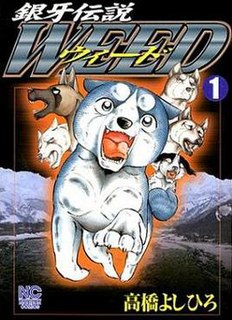 W
WGinga Legend Weed is a Japanese manga series written and illustrated by Yoshihiro Takahashi. It is a sequel to Takahashi's 1980s manga Ginga: Nagareboshi Gin, and focuses on Weed, the son of Gin, the original series' protagonist. Weed, named after the English word for wild plant, leaves his birthplace to search for his father in the Ōu Mountains. Upon arriving, Weed immediately begins protecting Ōu and its soldiers from dangerous threats. As the series progresses, Weed and his allies journey throughout Japan, aiding those in need and preventing takeovers.
 W
WGinga: Nagareboshi Gin is a Japanese manga series written and illustrated by Yoshihiro Takahashi. It was published by Shueisha in Weekly Shōnen Jump from 1983 to 1987, and collected in 18 bound volumes. It received the 1987 Shogakukan Manga Award for best shōnen series.
 W
WThe Great Catsby is a Korean webcomic written by Doha Kang and Kim Seung-jin. Daum published the comic in its original language on the internet. Netcomics, which holds the translation publication rights, published the comic in six volumes and on the internet in English. The title is a play on the classic novel by F. Scott Fitzgerald, The Great Gatsby.
 W
WHägar the Horrible is the title and main character of an American comic strip created by cartoonist Dik Browne, and syndicated by King Features Syndicate. It first appeared in February 1973, and was an immediate success. Since Browne's retirement in 1988, his son Chris Browne has continued the strip. As of 2010, Hägar is distributed to 1,900 newspapers in 56 countries and translated into 12 languages. The strip is a caricature commenting on modern-day life in the United States through a loose interpretation of Viking Age Scandinavian life.
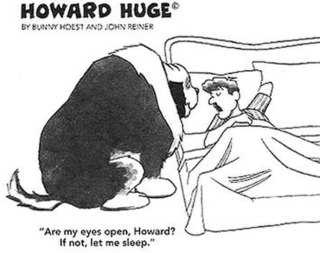 W
WHoward Huge is a cartoon series written by Bunny Hoest and illustrated by John Reiner. Created by Bill Hoest, the series had 80 million readers, since it ran in the Sunday supplement magazine, Parade from 1980 to 2007, continuing on a website.
 W
WJommeke is a Belgian comic strip series in publication since 1955. It was created by Jef Nys and can be defined as a humoristic children's adventure series. Jommeke, an 11-year-old boy, is the series' main protagonist. It was originally published in Kerk en Leven, before moving to Het Volk, where it ran until the newspaper went bankrupt in 2010. It is now published in Het Nieuwsblad, De Gentenaar and De Standaard.
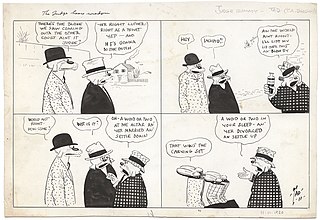 W
WJudge Rummy was an American comic strip by Tad Dorgan published from 1910 until 1922. It featured an anthropomorphic dog. Between 1918 and 1922 the character was also the subject of a series of short animated cartoons.
 W
WKrazy Kat is an American newspaper comic strip by cartoonist George Herriman, which ran from 1913 to 1944. It first appeared in the New York Evening Journal, whose owner, William Randolph Hearst, was a major booster for the strip throughout its run. The characters had been introduced previously in a side strip with Herriman's earlier creation, The Dingbat Family. The phrase "Krazy Kat" originated there, said by the mouse by way of describing the cat. Set in a dreamlike portrayal of Herriman's vacation home of Coconino County, Arizona, Krazy Kat's mixture of offbeat surrealism, innocent playfulness and poetic, idiosyncratic language has made it a favorite of comics aficionados and art critics for more than 80 years.
 W
WLaika is a graphic novel by Nick Abadzis that gives a fictionalized account of the life and death of the eponymous dog, the first living creature launched in orbital spaceflight.
 W
WLittle Orphan Annie is a daily American comic strip created by Harold Gray and syndicated by the Tribune Media Services. The strip took its name from the 1885 poem "Little Orphant Annie" by James Whitcomb Riley, and made its debut on August 5, 1924, in the New York Daily News.
 W
WLockjaw and the Pet Avengers is a four-issue comic book limited series published by Marvel Comics from July to October 2009. It was followed up by the four-issue limited series Lockjaw and the Pet Avengers Unleashed from May to August 2010. Both series were written by Chris Eliopoulos with art by Ig Guara.
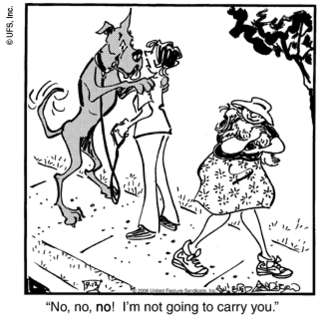 W
WMarmaduke is a newspaper comic strip revolving around the Winslow family and their Great Dane, Marmaduke, drawn by Brad Anderson from June 1954 to 2015.
 W
WMaus is a graphic novel by American cartoonist Art Spiegelman, serialized from 1980 to 1991. It depicts Spiegelman interviewing his father about his experiences as a Polish Jew and Holocaust survivor. The work employs postmodernist techniques and represents Jews as mice, Germans as cats, and Poles as pigs. Critics have classified Maus as memoir, biography, history, fiction, autobiography, or a mix of genres. In 1992, it became the first graphic novel to win a Pulitzer Prize.
 W
WMeebo and Zuky is a comic strip in the British children's comic strip magazine The Beano. It was introduced as one of three new strips in the Beano's Comic Idol competition, in June 2010, where the winner gets a permanent place in the comic. It was up against Home Invasion, about green aliens who want to invade Earth, and Uh, Oh, Si Co!, about a boy who'd get angry at the slightest annoyance. After three weeks of voting, the winner was announced to be Meebo & Zuky, so from the next week they were launched properly. It is drawn by Laura Howell, who has also drawn Beano Manga, Ratz and Johnny Bean from Happy Bunny Green for The Beano.
 W
WNapoleon and Uncle Elby was a popular syndicated newspaper comic strip created by Clifford McBride, which launched on June 6, 1932. Over a span of 29 years it was distributed to both American and foreign newspapers. By the mid-1940s, the strip was carried by 80 newspapers.
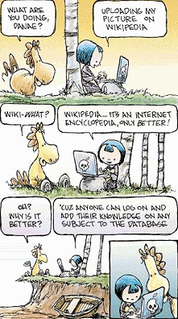 W
WNon Sequitur is a comic strip created by Wiley Miller starting February 16, 1992 and syndicated by Andrews McMeel Syndication to over 700 newspapers. It is also published on gocomics.com and distributed via email.
 W
WPeanuts is a syndicated daily and Sunday American comic strip written and illustrated by Charles M. Schulz that ran from October 2, 1950, to February 13, 2000, continuing in reruns afterward. Peanuts is among the most popular and influential in the history of comic strips, with 17,897 strips published in all, making it "arguably the longest story ever told by one human being". By the time of Schulz's death in 2000, Peanuts ran in over 2,600 newspapers, with a readership of around 355 million in 75 countries, and was translated into 21 languages. It helped to cement the four-panel gag strip as the standard in the United States, and together with its merchandise earned Schulz more than $1 billion.
 W
WPimpa or La Pimpa is an Italian comic strip, created by Francesco Tullio Altan, whose main character is a red-spotted female dog.
 W
WPogo was a daily comic strip that was created by cartoonist Walt Kelly and syndicated to American newspapers from 1948 until 1975. Set in the Okefenokee Swamp in the southeastern United States, Pogo followed the adventures of its funny animal characters, including the title character, an opossum. The strip was written for both children and adults, with layers of social and political satire targeted to the latter. Pogo was distributed by the Post-Hall Syndicate. The strip earned Kelly a Reuben Award in 1951.
 W
WPooch Café is a Canadian-American gag-a-day comic strip written and illustrated by Paul Gilligan. It was also made into a series of online shorts with RingTales.
 W
WPup Parade was a comic strip in the UK comic The Beano, starring the Bash Street Kids' dogs, known as the Bash Street Pups, and their many adventures. It made its first appearance in issue 1326, dated 16 December 1967, and was drawn by Gordon Bell. The dogs were all anthropomorphic facsimiles of their owners. Despite being each individually owned by members of the Bash Street Gang, they chose to live in knocked-over dustbins in an alley.
 W
WRantanplan is a fictional hound dog created by Belgian comics artist Morris and French writer René Goscinny. Originally a supporting character in the Lucky Luke series, Rantanplan later starred in an eponymous series. Rantanplan is a spoof of Rin Tin Tin. In the Turkish translations of the series, he is indeed named Rin Tin Tin. English versions of the books have renamed him "Rin Tin Can" and "Bushwack" in the 1983 Hanna-Barbera animated Lucky Luke television series, as well as "Rintindumb" in the Xilam Dalton series.
 W
WRex the Wonder Dog is a fictional superhero dog in the DC Comics universe. Created in 1952 by Robert Kanigher of Wonder Woman fame and artist Alex Toth, Rex has sometimes been compared to Superman's dog Krypto, who was created three years later. While the two canine crime fighters do share some similarities, they are decidedly different.
 W
WRocky is a Swedish autobiographical comic strip created by Martin Kellerman, focusing on an anthropomorphic dog, Rocky, and his friends in their everyday life in Stockholm.
 W
WWe3 is a three-issue American comic book mini-series by writer Grant Morrison and artist Frank Quitely, who describe its kinetic style as "Western Manga". It was published in 2004 by the Vertigo imprint of DC Comics, with a trade paperback released in 2005.